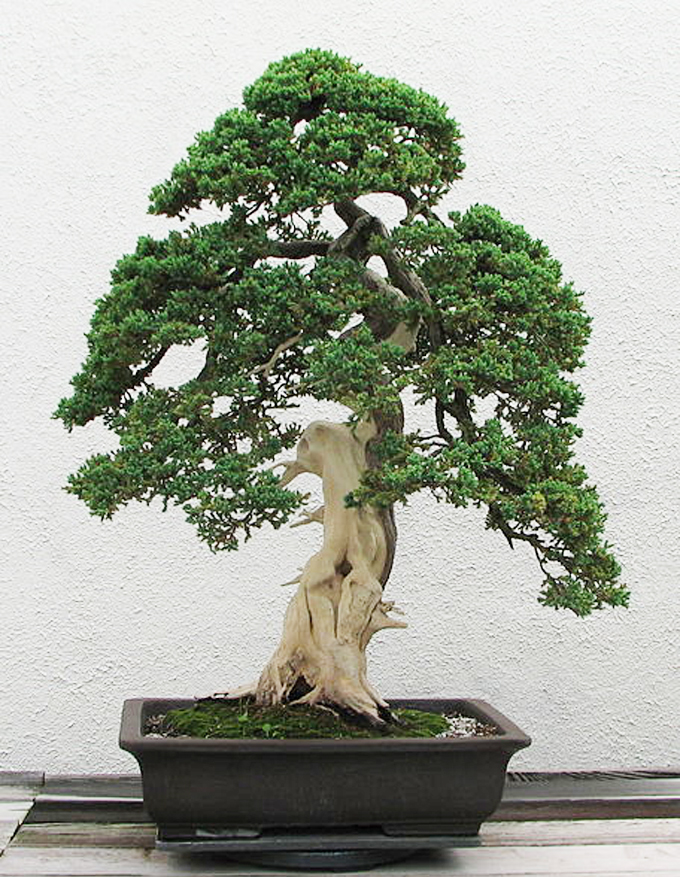 The back? Here’s what Wikipedia has to say about this tree: “A Dwarf Japanese Juniper (Juniperus procumbens ‘Nana’) bonsai on display at the National Bonsai & Penjing Museum at the United States National Arboretum. According to the tree’s display placard, it has been in training since 1975. It was donated by Thomas Tecza. This is the “back” of the tree.” This explanation begs at least two questions: why isn’t this view the front (you can scroll all the way down to see the front and decide for yourself)? and, is this a phoenix graft (isn’t the trunk way too massive for a procumbens nana)?
The back? Here’s what Wikipedia has to say about this tree: “A Dwarf Japanese Juniper (Juniperus procumbens ‘Nana’) bonsai on display at the National Bonsai & Penjing Museum at the United States National Arboretum. According to the tree’s display placard, it has been in training since 1975. It was donated by Thomas Tecza. This is the “back” of the tree.” This explanation begs at least two questions: why isn’t this view the front (you can scroll all the way down to see the front and decide for yourself)? and, is this a phoenix graft (isn’t the trunk way too massive for a procumbens nana)?
Long live Wikipedia!
I use Wikipedia a lot. Not so much for direct bonsai research, but for related botanical stuff, like confirming Latin names, plant ranges, plant diseases, etc. It’s also quite handy for exploring other non-horticultural passions, like ‘what was the name of that guy who….?’ I know you have to take some of facts with a small grain of salt (a little extra research doesn’t hurt), but mostly Wikipedia is reliable and easy to use.
Wiki Bonsai
In addition to everything else, Wikipedia has a wealth of useful bonsai information, especially for the uninitiated (I know I’m opening myself up to be shown a fool once again). Thus, this post, which is the result of stumbling upon a Wikipedia page titled ‘Bonsai Styles.’ I won’t say much more (you can check it out and decide for yourself how useful it is) but I will show you a few photos that I lifted and perhaps indulge in a passing comment or two.
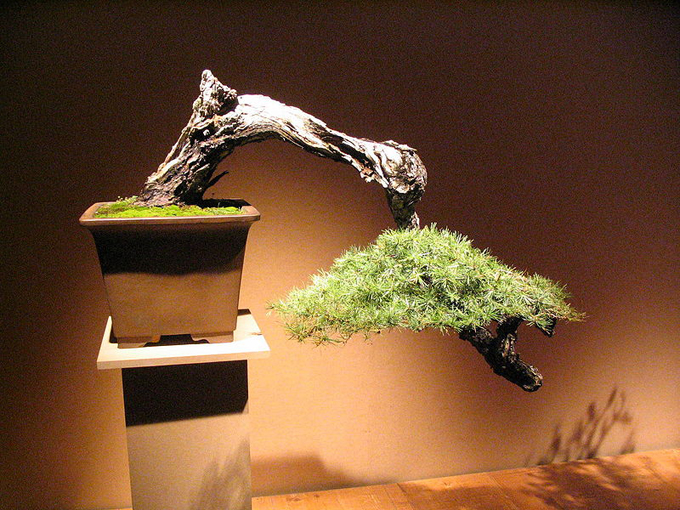 Cascading pine. The Wikipedia caption for this distinguished tree is a little light on information: “Bonsai at the “Foire du Valais” (Martigny, Switzerland, oct 2005) by Dake.” I’ll leave the rest up to you.
Cascading pine. The Wikipedia caption for this distinguished tree is a little light on information: “Bonsai at the “Foire du Valais” (Martigny, Switzerland, oct 2005) by Dake.” I’ll leave the rest up to you.
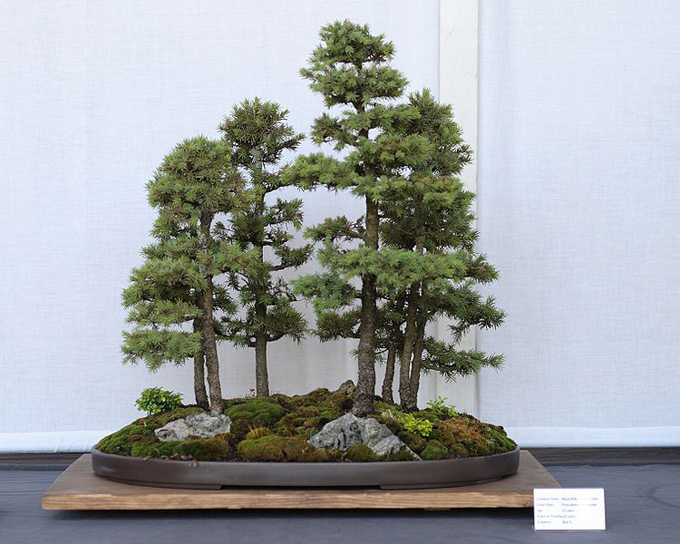 Coming down to earth a bit. This sweet, simple planting appears on the same Wikipedia page as the two more lofty trees above. Here’s the Wikipedia caption with its somewhat cryptic ending: “A bonsai forest planting of Black Hills Spruce (Picea glauca var. densata), with small dwarf boxwoods representing shrubs, on display at the 2008 exhibition of the Bonsai Society of Greater Hartford. Date 13 July, 2008, Source Own work, Author, Ragesoss.”
Coming down to earth a bit. This sweet, simple planting appears on the same Wikipedia page as the two more lofty trees above. Here’s the Wikipedia caption with its somewhat cryptic ending: “A bonsai forest planting of Black Hills Spruce (Picea glauca var. densata), with small dwarf boxwoods representing shrubs, on display at the 2008 exhibition of the Bonsai Society of Greater Hartford. Date 13 July, 2008, Source Own work, Author, Ragesoss.”
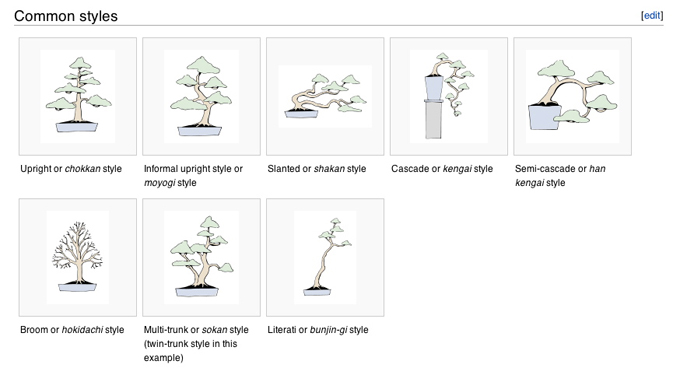 Simple illustrations can go a long way in clarifying basis principles. From Wikipedia.
Simple illustrations can go a long way in clarifying basis principles. From Wikipedia.
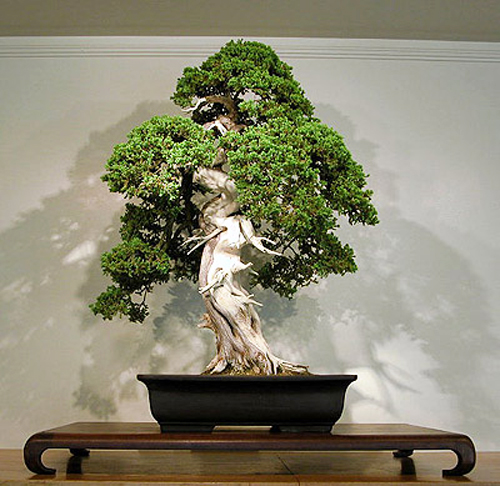 The front of the tree at the top of this post. This is only photo shown here that is not from Wikipedia. You can find it, and plenty of other photos of high quality bonsai at the National Bonsai & Penjing Museum’s website.
The front of the tree at the top of this post. This is only photo shown here that is not from Wikipedia. You can find it, and plenty of other photos of high quality bonsai at the National Bonsai & Penjing Museum’s website.
[quote]is this a phoenix graft (isn’t the trunk way too massive for a procumbens nana)?[/quote]
This tree is not a phoenix graft. I had the opportunity to see this this Procumbens nana bonsai
develop over the years, by going to the Midwest Bonsai Show. The history of these few Dwarf Japanese junipers that still exit is that they are the D-Hill nursery type and were dug from the foundation plantings around the old building. They were planted around 1936. That puts them in the range of 80 yr.s old. D-Hill had a retail store and a Bonsai section in addition to their wholesale operation. There are more of these trees in existence unless they have died. I remember one that was massive as wide as high. It was a beauty.
BTW– D-Hil nursery still has there wholesale in a Northern Illinois and still sell the D-Hill type
of Procumbens juniper.
Sometimes gardens that constantly show trees for a long time set the back towards the viewer so that the back of the tree can also get some sunlight.
When we moved into our home in 1994, I planted nine one-gallon J.procumbens on a raised bed of leaf mulch, in full sun, with sprinklers. In the next 8 yrs they became well over 12′ across. Some of the trunks are 9″-10″ across. Instead of tearing-out these “overgrown” conquerors, I used them for bonsai. I believe that much larger trunks have to be out there.
Hi Gary,
Thanks for the inside story. I’ve never heard of D-Hill type Pro-nanas and have never seen any pro-nanas from anywhere at any age that are nearly as big as this one. I believe you and am still skeptical at the same time (is this possible?).
Just looked up D-Hill online. Impressive look operation. No mention of Jun pro-nanas, but then they have hundreds of plant varieties.
Hi Micheal,
So, the evidence is mounting. I guess there is at least one special strain of pro-nana that I’m not familiar with. The largest I have ever seen, both Florida and California grown, are no more than 3″, maybe 4″ caliper.
I think the current front is the obvious choice. From the back, you can’t see the live vein emerging from the soil. For some reason, being able to see where the live vein emerges makes the tree look so much better. Maybe it has something to do with contrast, stability, or avoiding having the tree look like a tanuki.
Thanks LS,
I like your observations and must agree. The live vein is critical to understanding the tree.